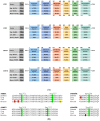Companion Animals as Models for Inhibition of STAT3 and STAT5
- PMID: 31861073
- PMCID: PMC6966487
- DOI: 10.3390/cancers11122035
Companion Animals as Models for Inhibition of STAT3 and STAT5
Abstract
The use of transgenic mouse models has revolutionized the study of many human diseases. However, murine models are limited in their representation of spontaneously arising tumors and often lack key clinical signs and pathological changes. Thus, a closer representation of complex human diseases is of high therapeutic relevance. Given the high failure rate of drugs at the clinical trial phase (i.e., around 90%), there is a critical need for additional clinically relevant animal models. Companion animals like cats and dogs display chronic inflammatory or neoplastic diseases that closely resemble the human counterpart. Cat and dog patients can also be treated with clinically approved inhibitors or, if ethics and drug safety studies allow, pilot studies can be conducted using, e.g., inhibitors of the evolutionary conserved JAK-STAT pathway. The incidence by which different types of cancers occur in companion animals as well as mechanisms of disease are unique between humans and companion animals, where one can learn from each other. Taking advantage of this situation, existing inhibitors of known oncogenic STAT3/5 or JAK kinase signaling pathways can be studied in the context of rare human diseases, benefitting both, the development of drugs for human use and their application in veterinary medicine.
Keywords: STAT3; STAT5; cancer models; companion animals; comparative oncology.
Conflict of interest statement
The authors declare no conflict of interest.
Figures


Similar articles
-
Disease Risk Assessments Involving Companion Animals: an Overview for 15 Selected Pathogens Taking a European Perspective.J Comp Pathol. 2016 Jul;155(1 Suppl 1):S75-97. doi: 10.1016/j.jcpa.2015.08.003. Epub 2015 Sep 28. J Comp Pathol. 2016. PMID: 26422413 Review.
-
Implications of STAT3 and STAT5 signaling on gene regulation and chromatin remodeling in hematopoietic cancer.Leukemia. 2018 Aug;32(8):1713-1726. doi: 10.1038/s41375-018-0117-x. Epub 2018 Mar 27. Leukemia. 2018. PMID: 29728695 Free PMC article. Review.
-
Spontaneously occurring tumors of companion animals as models for human cancer.Cancer Invest. 2000;18(8):781-92. doi: 10.3109/07357900009012210. Cancer Invest. 2000. PMID: 11107448 Review.
-
Defining the role of the JAK-STAT pathway in head and neck and thoracic malignancies: implications for future therapeutic approaches.Drug Resist Updat. 2010 Jun;13(3):67-78. doi: 10.1016/j.drup.2010.04.001. Epub 2010 May 14. Drug Resist Updat. 2010. PMID: 20471303 Review.
-
Antimicrobial resistance in clinical Escherichia coli isolated from companion animals in Australia.Vet Microbiol. 2017 Nov;211:43-50. doi: 10.1016/j.vetmic.2017.09.014. Epub 2017 Sep 21. Vet Microbiol. 2017. PMID: 29102120
Cited by
-
Targeting STAT3 and STAT5 in Cancer.Cancers (Basel). 2020 Jul 22;12(8):2002. doi: 10.3390/cancers12082002. Cancers (Basel). 2020. PMID: 32707820 Free PMC article.
-
Toxicity Profile of eBAT, a Bispecific Ligand-Targeted Toxin Directed to EGFR and uPAR, in Mice and a Clinical Dog Model.Toxins (Basel). 2024 Aug 26;16(9):376. doi: 10.3390/toxins16090376. Toxins (Basel). 2024. PMID: 39330834 Free PMC article.
-
Polyphenols and Cannabidiol Modulate Transcriptional Regulation of Th1/Th2 Inflammatory Genes Related to Canine Atopic Dermatitis.Front Vet Sci. 2021 Mar 5;8:606197. doi: 10.3389/fvets.2021.606197. eCollection 2021. Front Vet Sci. 2021. PMID: 33763461 Free PMC article.
References
-
- Withrow S.J., Vail D.M. Withrow & MacEwen’s Small Animal Clinical Oncology. 5th ed. Saunders Elsevier; Philadelphia, PA, USA: 2013.
Publication types
LinkOut - more resources
Full Text Sources
Miscellaneous

